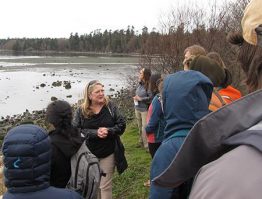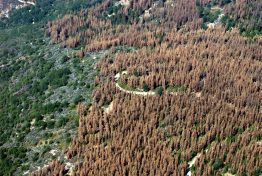Ice cores offer a window into the history of Earth’s climate. Layers of ice reveal past temperatures, and gases trapped in bubbles reveal past atmospheric composition. The oldest continuous ice core so far comes from Dome C in East Antarctica and extends back 800,000 years. But a tantalizing clue recently offered the possibility to go back even further. A collaborative study between the University of Washington and the University of Maine now pinpoints a location where an entire million years of undisturbed ice might be preserved intact.
Read more at UW Today »Two UW Environment undergrads receive Udall scholarships
Aquatic and Fishery Sciences‘ Ashley Lewis and Environmental and Forest Sciences‘ Alishia Orloff, both juniors at UW, will join 50 students from around the country as Udall Scholars. A competitive award, the review committee selected this year’s scholars from 437 nominees based on the students’ commitment to careers in the environment, Native health care or tribal policy, as well as their leadership potential, public service and academic achievements.
Learn more about this year's Udall scholars »A closer look at shorelines
For some people, shorelines are places to sit and admire a sunset. For others, they are fascinating ecological or geological zones. For Cleo Woelfle-Erskine and July Hazard, shorelines are all of this and more. During the spring, Woelfle-Erskine and Hazard oversee a course that teaches undergraduate and graduate students in field writing, involving visits to tribal communities and explorations of shoreline histories and ecologies.
Read more at UW College of Arts and Sciences »Q&A with UW Environment volcano and magma expert George Bergantz
The University of Washington’s College of the Environment and its faculty members are no strangers to ground-breaking and important research on volcanoes and magma—from a land-sea experiment tracking earthquakes and volcanoes along the Alaska Peninsula to publishing an atlas of seafloor volcanoes and deep-ocean life. George Bergantz, a professor in the College’s Department of Earth and Space Sciences, is a geologist who studies the physics of magma.
Read more »Forest loss in one part of US can harm trees on the opposite coast
Large swaths of U.S. forests are vulnerable to drought, forest fires and disease. Many local impacts of forest loss are well known: drier soils, stronger winds, increased erosion, and loss of shade and habitat. But if a whole forest disappears, new research shows, this has ricocheting effects in the atmosphere that can affect vegetation on the other side of the country.
Read more at UW Today »





